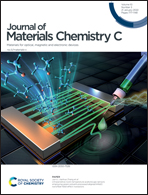ESIPT-capable Eu3+-metallopolymer with colour-tunable emission for selective visual sensing of Zn2+ ion†
Abstract
In this work, the vinyl-functionalized and ESIPT-capable (ESIPT = excited-state intramolecular proton transfer) 4-VP-PHI (3-(1H-phenanthro[9,10-d]imidazol-2-yl)-4′-vinyl-[1,1′-biphenyl]-4-ol) with fluorescence sensing towards Zn2+ (LOD (limit of detection) = 12.7 μM) while excluding Cd2+ and Hg2+ ions was constructed. Further, based on the copolymerization between 4-VP-PHI, MMA (methyl methacrylate) and the organo-Eu3+-complex monomer [Eu2(BTP)3(4-VP-BPY)2] (H2BTP = (Z)-4,4,4-trifluoro-3-hydroxy-1-(3-((Z)-4,4,4-trifluoro-1-hydroxy-3-oxobut-1-en-1-yl)phenyl)but-2-en-1-one; 4-VP-BPY = 5-(4-vinylphenyl)-2,2′-bipyridine), a white light-emitting Eu3+-metallopolymer Poly[(4-VP-PHI)-co-Eu-co-MMA] through the colour-integration of the residue emission from the polymer backbone and the Eu3+-centred red emission, was also successfully developed. Interestingly, the synthesized Eu3+-metallopolymer not only has a lower LOD (3.49 μM) for the selective sensing of Zn2+ ions but also exhibits a remarkably emissive colour change from white to blue as compared to 4-VP-PHI (only from bluish green to blue green upon Zn2+ stimulation). The presented strategy engenders Eu3+-metallopolymers an opportunity to develop highly sensitive fluorescent probes for the visual detection of Zn2+ ions.



 Please wait while we load your content...
Please wait while we load your content...